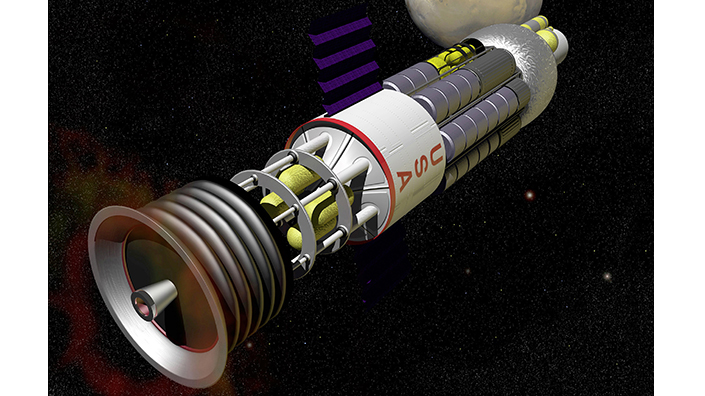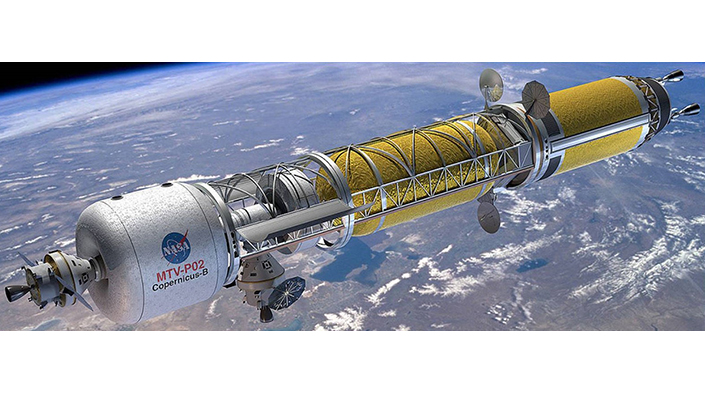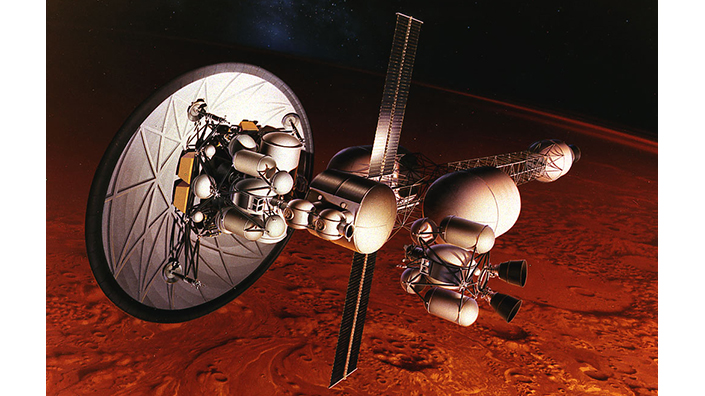This article looks at what is known about nuclear propulsion. We examine some of the nuclear-powered jet and rocket engines that have been tested in the past, the early design studies that have shown how nuclear propulsion could transform space travel.
Cold War aircraft engines
There was a great deal of interest in nuclear propulsion in the early Cold War era. During the 1950s, the US and the USSR developed working nuclear-powered jet engines for aircraft. The purpose of these engines was to allow nuclear bombers to remain airborne for prolonged periods, providing a constant nuclear deterrent. However, the more rapid development of intercontinental ballistic missile systems meant that this capability was no longer required and nuclear-powered bombers never entered service.
These were essentially turbojets, with compressor air intakes, followed by a chamber where the compressed air was heated. However, instead of the heating taking place in a combustion chamber where fuel was burnt, a small nuclear reactor was used to heat the air. Two types of engine were developed. Direct Air Cycle engines allowed air to pass directly through the reactor core, while Indirect Air Cycle engines used a heat exchanger with a coolant fluid such as molten metal or salt.
There were two major issues with nuclear jet engines. Firstly, they created radioactive pollution. Although indirect air cycle engines were intended to reduce this, the radiation released remained significant. Secondly, in the event of a crash, there would be major contamination. Intercontinental ballistic missiles avoided these issues and so became the preferred way to provide a nuclear deterrent.
Nuclear pulse propulsion
Around the same time as nuclear jet engines were being developed for bombers, there was growing interest in using nuclear power for space flight. Nuclear pulse propulsion was proposed as a way to provide high thrust and specific impulse.
The fundamental concept was to detonate nuclear explosions behind a reaction surface on a spacecraft, to push the craft forward. The original concept was to eject small directional nuclear explosives that would detonate some distance behind the spacecraft. This approach is now known as external pulsed plasma propulsion. Each explosive device would contain a disc of propellant material designed to produce a jet of plasma on detonation. The plasma cloud would impact on a large pusher plate at the back of the spacecraft, providing huge amounts of thrust at very high specific impulse (requiring little reaction mass).

A concept for a pulsed nuclear fission propulsion system, part of the US Project Orion
A crewed spacecraft using this type of propulsion would require a very large shock absorber between the pusher plate and the crew module, to even out the pulses of accelerations produced by the nuclear detonations.
The first detailed study of external nuclear pulse propulsion was Project Orion, which was carried out between 1958 and 1965. This study concluded that it was possible, using 1960s technology, for a spacecraft with a crew of more than 200 people to complete a round-trip mission to Mars in four weeks or around Saturn’s moons in seven months. The researchers also believed that they had solutions for crew shielding and pusher plate ablation. One issue that was not fully resolved was the nuclear fallout produced by the first few detonations, which would be within Earth’s atmosphere. The impact of a failed launch could also be catastrophic.
Inertial confinement fusion
Over the years, there have been many attempts to improve on Project Orion’s design concepts. One possibility is to have much smaller and more frequent nuclear detonations, which actually occur inside a containment vessel mounted directly to the back of a spacecraft. Such an approach requires the perfection of inertial confinement fusion, with high-energy beams such as lasers used to initiate fusion in a fuel pellet.
During the 1970s it was believed that inertial confinement fusion would develop rapidly and therefore this form of propulsion was under consideration. Project Daedalus envisaged a relatively steady stream of plasma from such an engine. NASA continued to develop this concept in the 1980s in Project Longshot. This planned to use a fission reactor to generate electricity that would power the inertial confinement lasers as well as other on-board systems including a communications laser.

A nuclear rocket designed for missions beyond Mars
The much slower than expected rate of development in inertial confinement means that these concepts remain highly speculative. Research into nuclear pulse propulsion is continuing with ideas such as using antimatter to catalyse nuclear reactions and hybrid magneto-inertial fusion under consideration.
Direct fusion drive
Over the past decade, research has focused on developing a direct fusion drive. This is very similar to the inertial confinement concepts proposed in the 1970s but would use toroidal magnetic confinement to control the fusion reaction and to direct the resulting jet of plasma. Charged reaction products would be magnetically directed into a jet and augmented by additional propellant. Design studies show this has the potential to achieve very high thrust and specific impulse while also being controllable and producing auxiliary power.
Johndale Solem’s Medusa design goes back to the technically simpler external pulsed plasma propulsion, but would have the nuclear detonations occur in front of the spacecraft, with a huge sail deployed even further forward to catch the plasma and pull the spacecraft forward. There are two advantages to this approach. Firstly, it becomes much easier to smooth out the acceleration of the capsule. Instead of a large shock absorber in compression, a simple cable in tension can be used. It also becomes easy to generate electricity in the capsule, by reeling out the cable as the explosions impact.
Nuclear thermal propulsion – the future of space travel?
Nuclear thermal propulsion (NTP) uses the heat from a nuclear reaction to heat a propellant. This is similar to the early nuclear aircraft engines discussed above. However, with a rocket engine the propellent must be provided from internal tanks. Currently the most popular configuration is to use a fission reactor to heat liquid hydrogen which then expands through a conventional rocket nozzle to produce thrust. This approach cannot achieve the orders of magnitude improvements possible for plasma propulsion; a more modest improvement in payload of two to three times is expected. It has been suggested that, compared to a chemical rocket, an NTR could reduce transit time from Earth to Mars from 240 days to 100 days. Reduced transit time is important for crew health, reducing exposure to radiation and time in microgravity. However, this transit time is still far more than the 28 days that Project Orion predicted could be achieved using nuclear pulse propulsion.

A design for a nuclear-thermal rocket with an aerobrake disc
Jeff Thornburg, CEO of Interstellar Technologies, says: “I believe that modern fission reactors powering nuclear thermal propulsion systems are the next achievable step to increase specific impulse for human and non-human exploration of the solar system within our lifetimes. The movement of the significant mass required for human exploration requires thrust levels only achievable with NTP systems presently. NTP is a technology focus area for my company, Interstellar Technologies.”
Engines for trips to Mars
The first NTP rocket engines were developed during the 1950s, with the work closely related to the nuclear aircraft engines being developed at the same time. The designs were similar to direct air cycle nuclear engines, with the control rods directly heating the propellant. Extensive ground testing was carried out; the Phoebus-2A Project Rover was the most powerful engine tested at 4.5GW. It produced 250,000 pounds of thrust with 850 seconds of specific impulse and its longest test involved a burn time of 90 minutes. Later NASA programmes such as the Nuclear Engine for Rocket Vehicle Application (NERVA) produced engines that were ready for human missions to Mars, but NASA’s development of nuclear rockets stopped in 1973.
In 2018 and 2019 new research funding was allocated for NASA to restart NTP research. The aim is to make a test flight in 2024. Last summer Elon Musk tweeted “Nuclear thermal rocket for fast transit around solar system would be a great area of research for @NASA,” seemingly suggesting that, while private companies move forward with the mature technologies of chemical rockets, NASA could focus on NTP development. However, none of NASA’s current manifest of missions planned through to 2028 mentions the use of nuclear propulsion.
Outlook for nuclear propulsion
It’s looking like we may finally be about to enter the age of nuclear-powered space flight. External pulse propulsion remains the only current technology feasible for crewed missions to more distant destinations such as Saturn’s moons and even the stars. A direct fusion drive may provide even higher performance in the future. However, it is the much more technically mature nuclear thermal propulsion systems that are likely to be seen on operational spaceflights in the next few decades.
Russia’s renewed interest in nuclear-powered missile systems may also stimulate development in the west.
Want the best engineering stories delivered straight to your inbox? The Professional Engineering newsletter gives you vital updates on the most cutting-edge engineering and exciting new job opportunities. To sign up, click here.
Content published by Professional Engineering does not necessarily represent the views of the Institution of Mechanical Engineers.